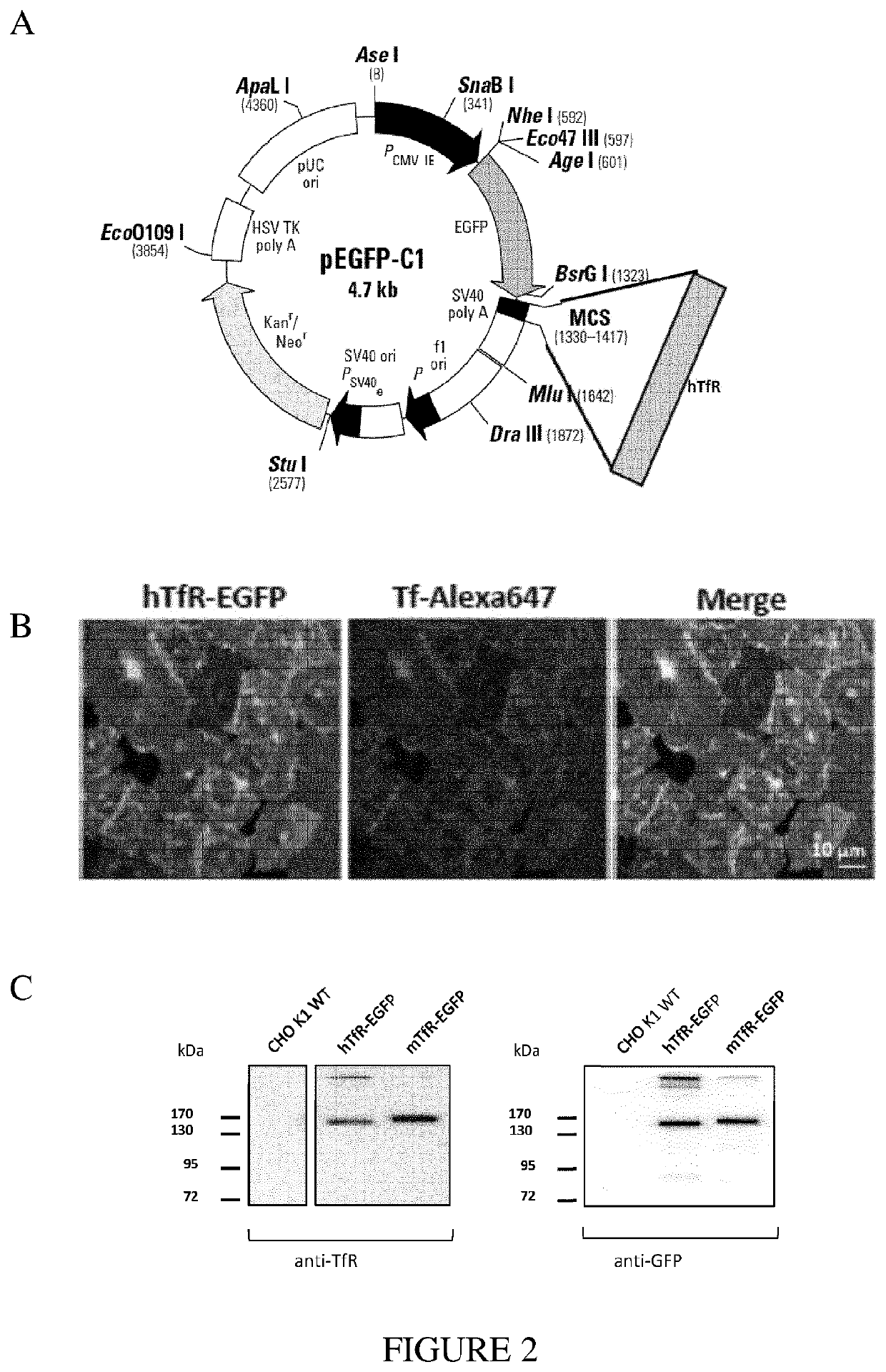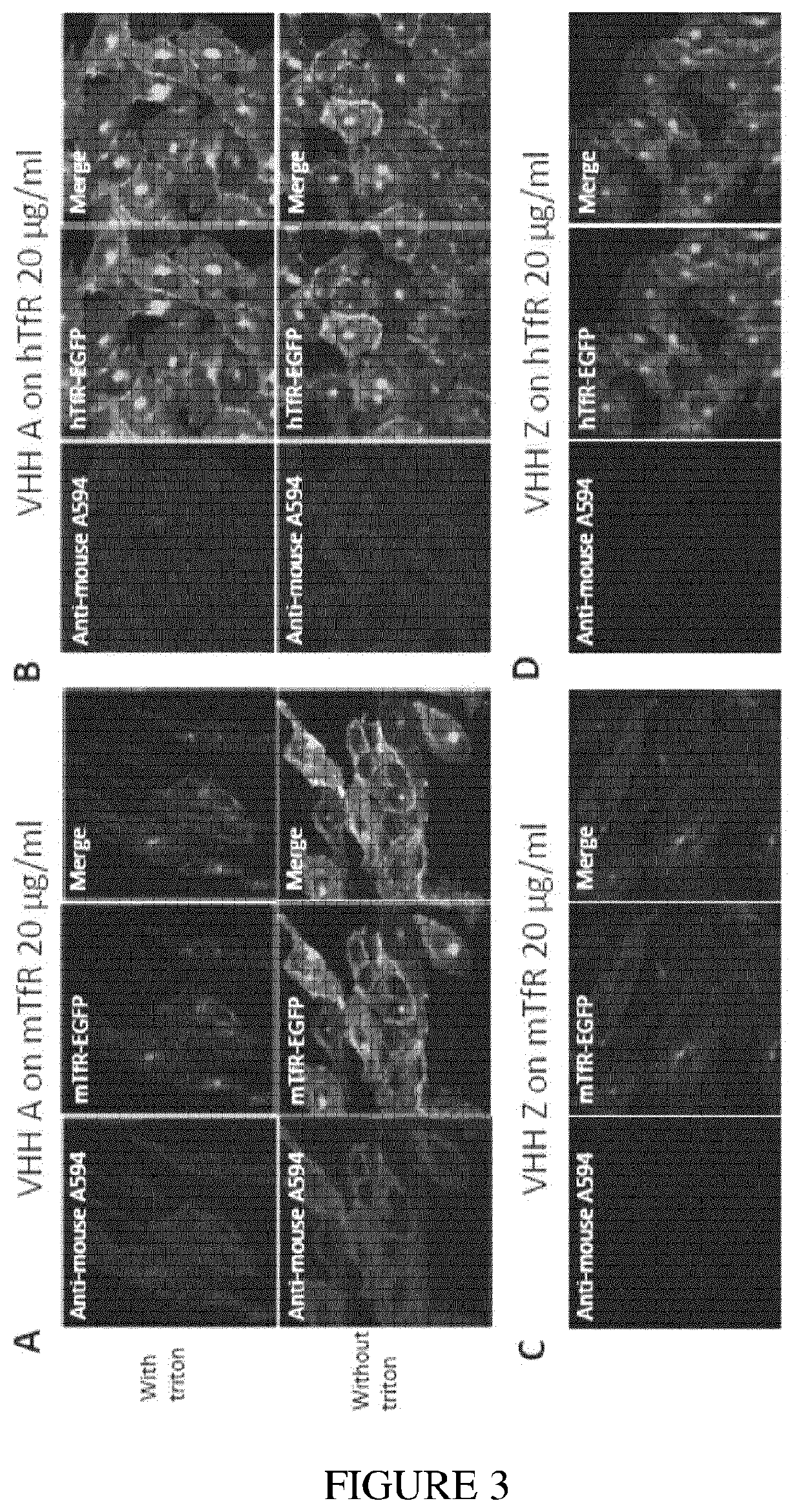Transferrin receptor-binding molecules, conjugates thereof and their uses
- Summary
- Abstract
- Description
- Claims
- Application Information
AI Technical Summary
Benefits of technology
Problems solved by technology
Method used
Image
Examples
example i
[0226]Validation of TfR Expression at the BBB.
[0227]We analyzed cell membrane expression profile of the TfR in brain endothelium of various species. The kit ProteoExtract Subcellular Proteome Extraction Kit (Calbiochem, La Jolla, Calif., USA) was used to prepare membrane extracts of digested or non-digested brain microvessels (BMVs) and of primocultures of brain microvascular endothelial cells (BMEC) from rat, mouse, pig and non-human primate (NHP; rhesus monkey) (FIG. 1).
[0228]Membrane extracts were quantified using the BioRad DC Protein Assay (Bio-Rad, Hercules, Calif., USA) following manufacturer's instructions. Membrane proteins were separated by sodium dodecyl sulfate polyacrylamide gel electrophoresis (SDS-PAGE) on 4-12% polyacrylamide gels, and transferred onto nitrocellulose membranes (ThermoFisher Scientific). Proteins were probed with a primary antibody against TfR (Genetex GTX102596; 1 / 1000), followed by an HRP-conjugated donkey anti-rabbit IgG secondary antibody (Jackson...
example ii
[0231]Construction of CHO Cell Lines Stably Expressing Human and Mouse TfR.
[0232]The prerequisite to the identification and characterization of TfR-binding VHHs was the establishment in eukaryotic cells (Chinese hamster ovary cells, CHO) of stable cell lines expressing hTfR and mTfR, constitutively and at high rates. These cell lines were then used i) for the identification and characterization of agents binding to the receptor expressed at the cell surface, in its native configuration; and ii) to test whether the receptor could internalize such agents by endocytosis.
[0233]For the construction of these cell lines, the cDNA coding for the hTfR was cloned using sequence information available in databases (accession number: NM_003234.3). The primers necessary for cDNA amplification by RT-PCR were selected (see table below), comprising at their end (in bold type) the restriction sites (EcoRI and SalI) necessary for cloning in the pEGFP-C1 expression vector (Clontech) (FIG. 2-A).
Receptor...
example iii
[0240]Generation of VHHs that Bind the TfR.
[0241]A llama (Lama glama) was immunized subcutaneously 4 times with membrane preparations from CHO stable cell lines expressing the human and murine receptors of interest. VHH library construction was performed as previously described (Alvarez-Rueda et al., 2007, Behar et al., 2009). Briefly, mRNAs coding for VHH were amplified by RT-PCR from the total RNAs of peripheral blood mononuclear cells isolated by ficoll gradient, and cloned into the pHEN1 phagemid. Reiterative selections enabled the isolation of phages presenting VHH exhibiting strong affinity for the TfR expressed at the cell surface.
[0242]In total, more than 700 clones were screened for their ability to bind the TfR, and roughly 100 clones were sequenced.
[0243]VHHs with improved binding (to both the murine and the human cell lines), cell penetration and transport properties were obtained. Illustrative VHH are VHH A, VHH B, VHH C, VHH D (see also the list of sequences). These VH...
PUM
| Property | Measurement | Unit |
|---|---|---|
| Molar density | aaaaa | aaaaa |
| Molar density | aaaaa | aaaaa |
| Composition | aaaaa | aaaaa |
Abstract
Description
Claims
Application Information
 Login to View More
Login to View More - Generate Ideas
- Intellectual Property
- Life Sciences
- Materials
- Tech Scout
- Unparalleled Data Quality
- Higher Quality Content
- 60% Fewer Hallucinations
Browse by: Latest US Patents, China's latest patents, Technical Efficacy Thesaurus, Application Domain, Technology Topic, Popular Technical Reports.
© 2025 PatSnap. All rights reserved.Legal|Privacy policy|Modern Slavery Act Transparency Statement|Sitemap|About US| Contact US: help@patsnap.com



